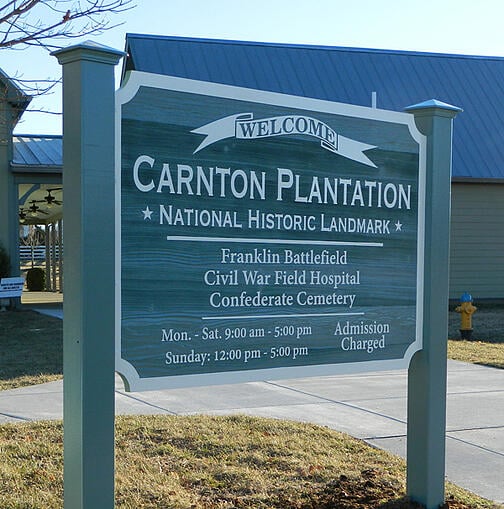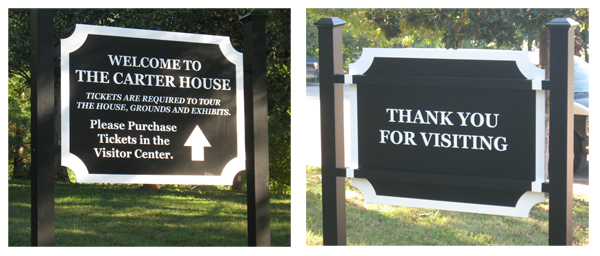This month marks the 150th Anniversary of the Battle of Franklin. Most of the land in Franklin that saw the bloodshed from the war has since been turned into paved roads, neighborhoods, office locations and retail stores. However, through the preservation efforts of groups like The Battle of Franklin Trust, Franklin's Charge, The Heritage Foundation and the Williamson County Convention and Visitor's Bureau, more and more of the battlefield is being reclaimed and preserved to commemorate Franklin's history and the story of the Battle of Franklin. There are a number of events throughout the month, which commemorate the battle and pay tribute to those who lost their lives.
We are lucky to work (and some of us even live) in the quaint and historic city of Franklin. While working with The Battle of Franklin Trust in late 2013, we had the privilege of making outdoor signs for two historic landmarks that witnessed the bloodshed of the Battle of Franklin. These homes, the Carnton Plantation and The Carter House, also acted as makeshift hospitals during the aftermath of the battle. Thankfully, the preservation efforts of The Battle of Franklin Trust allow us to visit these homes today to take a step back in time to witness the signs of the battle and the days that followed.
 The sandblasted redwood post and panel welcome sign was painted with a special blue color that coordinates with the accent colors in the visitor's center.
The sandblasted redwood post and panel welcome sign was painted with a special blue color that coordinates with the accent colors in the visitor's center.
The Carnton Plantation was built in 1826 by Randal McGavock (1768-1843), Nashville's 11th mayor. The plantation was named after his family's home in Ireland. Upon Randal's death, his son, John McGavock, inherited the home. John, his wife Carrie, and two of their children witnessed the bloodshed and horrors of the Battle of Franklin on the evening of November 30, 1864. Hiding inside their home, they waited for the fighting to end. Once it did, the home became the largest field hospital in the area. The wounded soldiers filled the home and eventually the yard as well. At one time, the remains of four Confederate generals lay on the back porch of the historic mansion.
During the days after the battle, the remaining Confederate soldiers attempted to identify and bury as many of the fallen soldiers. Their bodies were quickly placed in shallow graves. At the conclusion of the war, the federal government would not relocate the bodies of those soldiers. The McGavocks donated 2-acres of their land as a final resting place for almost 1,500 Confederate soldiers. Carrie McGavock watched over the cemetery and kept record of the soldiers' identities until her death in 1905. The McGavock family owned the plantation until 1911. In 1973, the mansion and its grounds were listed on the National Register of Historic Places. To this day, the cemetery is the largest privately owned military cemetery in the country. It is a moving tribute to the fallen soldiers.
 The 1/8" aluminum post and panel welcome sign we designed and installed for The Carter House. We used both sides of the sign to include a 'welcome' message and
The 1/8" aluminum post and panel welcome sign we designed and installed for The Carter House. We used both sides of the sign to include a 'welcome' message and
a 'thank you for visiting' message.
The Carter House was built in 1830 by Fountain Branch Carter, a successful farmer, merchant, surveyor and cotton gin operator. The Carter House is located just a mile west of the Carnton Plantation. Fountain and his wife, Mary, had 12 children. Three of their sons became Confederate soldiers and fought in the Civil War. When the Battle of Franklin began, the family fled to their basement to hide. Twenty-three people remained in the basement until the battle ended. When they emerged from their home after the fighting had stopped, they found hundreds of dead or dying soldiers around their home. Among those soldiers was their 24-year old son, Tod. They brought his injured body into the home, but he died two days later. In the days after the battle, and similar to the Carnton Plantation, the home became a hospital to those soldiers injured in the battle. The State of Tennessee purchased The Carter House in 1951. Along with the Carnton Plantation, the Battle of Franklin Trust manages both locations.
If you are interested in participating in any of the events for the 150th Anniversary of the Battle of Franklin, click here for a complete listing. The re-enactments of two different scenes in the battle will occur on Saturday, November 15 and Sunday, November 16. Over 700 re-enactors from around the country are expected to participate. This is an event you will not want to miss!
Looking for your own outdoor sign? Contact us today to get a free quote and consultation on your project.
(Sources: The Battle of Franklin Trust, Your Williamson, The Tennessee Magazine)



Leave a Reply